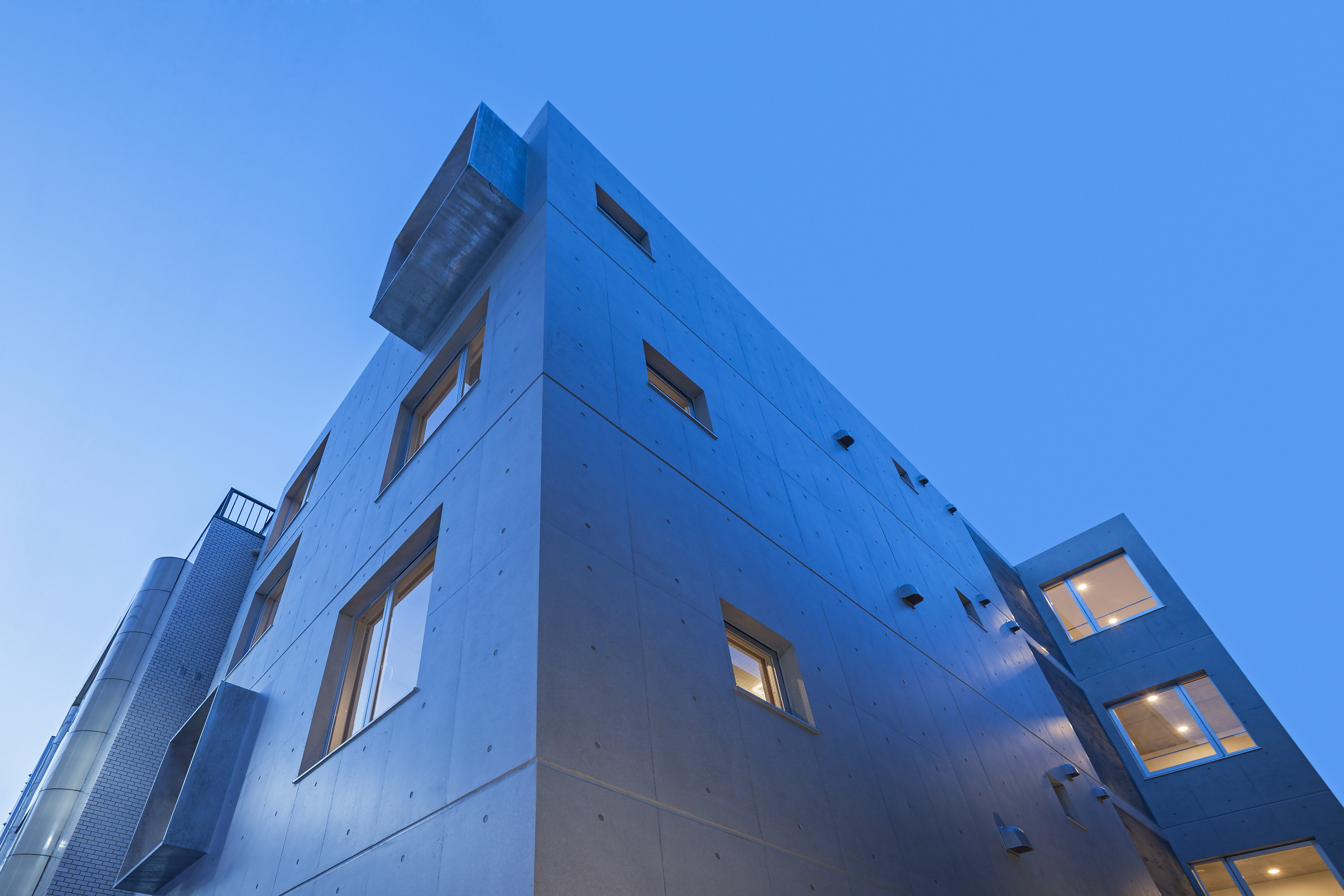









中延は、東京都心部の南に隣接する国道沿いの街。饅頭屋とジャズフェスティバルが同居し、老若男女が集い暮らす活気あふれる近隣商業地である。本敷地もまた賑やかな駅前商店街に面し、銭湯や新聞配達店が軒を並べる一角に存在する。細やかな生活の息づく街への影響に配慮して、周辺建物とスケールを揃え地上4階、12戸のつつましやかな構成とした。
下階から上階に向けてずれながらひろがる開口配置は、ファサードに浮遊感を与えコンクリートのマッシブな重量感を軽減する試みである。幅員わずか6mの前面道路に適切な距離をとるため、商店街から敷地内部に路地を引きこみ、落ち着きとプライヴァシーを重視したエントランス空間を演出した。共用部は最小限に抑え、シンプルかつ効率的な平面計画としている。
住戸内部は白い壁とコンクリート打放しだけで構成し、無駄をそぎ落としたシンプルなディテールを追求した。意匠のみならず計画においても、シンプリシティを徹底した。クローゼットを廃し自立壁だけで仕切られた収納スペースを採用、キッチンシンクで洗面台を兼ねるなど、集合住宅の最小限の形を追求し、モノに支配されない豊かさ、持たない生活の形を提案している。すなわちライフスタイルと直結したミニマリズムである。
一方、残された最小限の要素は、新たな住み暮らし方のきっかけを提供するよう計画した。用途を限定しない収納は居心地の良い書斎にもなる。広々としたコンクリートのキッチンカウンターはデスクとして使用できる。徹底したシンプリシティからは新たな自由度が生まれると考えたのである。
この建物のあらゆる開口部は、「正方形」をしている。「水平性」「垂直性」といった近代らしさの約束事から自由になってみたとき、「正方形」は最も純粋でプリミティブな開口の形である。建物内外のすべての空間が、これら純粋な開口だけを介してリズミカルに接続する。
内外の関係においては、これらの開口が<内部 ― シンプル、ミニマル>と、<外部 ― 賑やかな喧噪>とを媒介し、適切に制御する装置となるよう計画した。多様な色彩の光あふれる商店街の風景が、この「正方形」で切り取られ、静謐な室内の壁に配置されることで、緩衝され制御されたシーンとなる。いわば室内においては、切り取られた都市の光景こそが唯一の装飾となる。一方外部においては、道路へと突き出した鋼板のフレームが時間に応じて多様な陰影を生み、ファサードに象徴的な表情を与える。このフレームはまた、新旧とりどりの街の風景を反射して室内へも取り込み、室ごとの景色に変化をもたらしている。
また、室面積や近隣との距離に比して開口を大きめに計画することで、光と風を多く取り入れるとともに、街との繋がり、空間的一体性を居住者が自在に制御できるようにも配慮した。
共同設計:奥村梨枝子/Atelier O
Producer:株式会社モデリア
照明:株式会社ライティング創
施工:株式会社マゴメ工務店
建物管理:株式会社アルファーマネジメント&パートナーズ
施主:秀光建設株式会社
場所: 東京都品川区戸越6-23-16
延床面積: 331.19m2
竣工:2016年2月
受賞
アイコニック賞 2016, Winner (Germany)
ドイツデザイン賞 2017, Special Mention (Germany)
International Design Awards 2016, Honorable Mention (USA)
アイコニック賞 2016, Winner (Germany)
ドイツデザイン賞 2017, Special Mention (Germany)
International Design Awards 2016, Honorable Mention (USA)
This project is located close to the Nakanobu shopping lane, south of the central district of Tokyo. The town is a mixture of old stalls and new shops: from a small grandmother’s confectionery shop aimed for children to a larger scaled jazz festival — everyone, pensioners and young couples, all share the same street happily together. The location of the project is near a newsstand and a bathhouse. To be incorporated into the humble yet lively town, the building’s scale has been restrained in consideration of the neighbouring buildings, summing up into a four-storey structure with just twelve units.The purposefully unaligned positioning of the window openings on the facade of the building concentrated at the bottom and gradually spreading upwards, portray an effect of a floating-like sensation, to reduce the massive weightiness of the concrete. The entrance is given the element of privacy as it is hidden by a narrow pathway leading the residents away from the vibrant street in front of the building.In the simplest way possible, the interior is completely composed of exposed concrete and plain white walls. The planning and design of the structure aim to convey a set of modest conventions: independent walls which replace a closet, one tap dual-tasking cooking and handwashing. These propose a minimalistic approach in architecture and the lifestyle of the residents: a collective dwelling, not reliant on possessing, but rather finding the richness of not having. Minimalism in this project is a direct connection to a way of living that is promoted. However, some of the architectural elements are designed to stimulate an innovative style of inhabitation. For instance, the storage walls could flexibly transform into a small cosy room, while the large concrete kitchen counter could essentially be also used as a desk. Simplicity with purpose allows for a new form of spatial flexibility.In the building, every single opening, such as the windows, takes a square-shaped form. Thinking outside of the modernist style conventions, windows following either a vertical or a horizontal layout, ‘square’ may be found to be the purest and most primitive form of an opening. Within this project, every space of the interior and exterior of the building is found to be rhythmically connected throughout the purest element of the square. Windows in particular hold an important position in mediating and controlling the interpretation of the interior, as a place of minimalism and simplicity, with the exterior, as a lively bustling city, of the structure.The energetic and colourful atmosphere of the shopping lane trimmed into the square openings, framing the scenery within the interior windows — allow for it to become a muted and controlled scene: shaping the town as an exterior element of ornamented view for the residents. In addition, the galvanised steel window frames cast shadows at various angles to add a non-uniform expression to the facade, consequently visible as distinctive icons in the cityscape. These shadows reflect into the interior of the building, allowing for a richer experience and variety of city views for the residents.
Collaboration with Rieko Okumura
Architects: Ryuichi Sasaki/Sasaki Architecture + Rieko Okumura/Atelier O
Design Team: Gen Sakaguchi, Michal Rogozinski/Sasaki Architecture
Producer: Hidetaka Gonai/Modelia Co.,LTD
Client: Nobumitsu Ohashi/Shukou Kensetsu Co.,LTD
Light Design: Natsuha Kameoka / Lighting Sou
Contractor: Magome Construction Company
Photo: Takumi Ota, Bauhaus Neo
Location: 6-23-16 Togoshi, Shinagawa-ku, Tokyo, Japan
Area: 331.19m2
Completion Date: February , 2016
Building Purpose: Residential Housing
Awards/Prizes
Design Team: Gen Sakaguchi, Michal Rogozinski/Sasaki Architecture
Producer: Hidetaka Gonai/Modelia Co.,LTD
Client: Nobumitsu Ohashi/Shukou Kensetsu Co.,LTD
Light Design: Natsuha Kameoka / Lighting Sou
Contractor: Magome Construction Company
Photo: Takumi Ota, Bauhaus Neo
Location: 6-23-16 Togoshi, Shinagawa-ku, Tokyo, Japan
Area: 331.19m2
Completion Date: February , 2016
Building Purpose: Residential Housing
Awards/Prizes
Iconic Awards 2016, Winner (Germany)
German Design Awards 2017, Special Mention (Germany)
International Design Awards 2016, Honorable Mention (USA)
German Design Awards 2017, Special Mention (Germany)
International Design Awards 2016, Honorable Mention (USA)